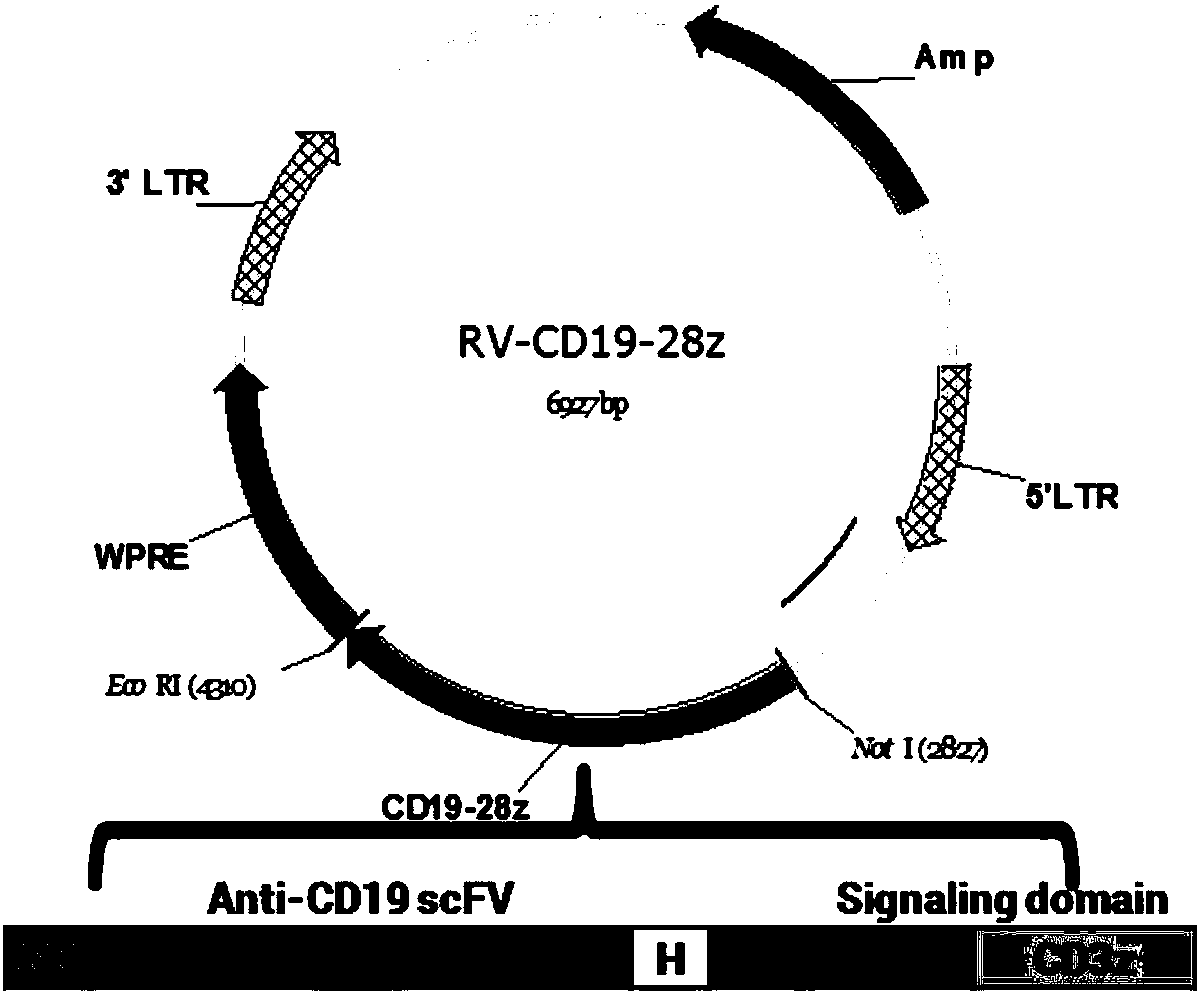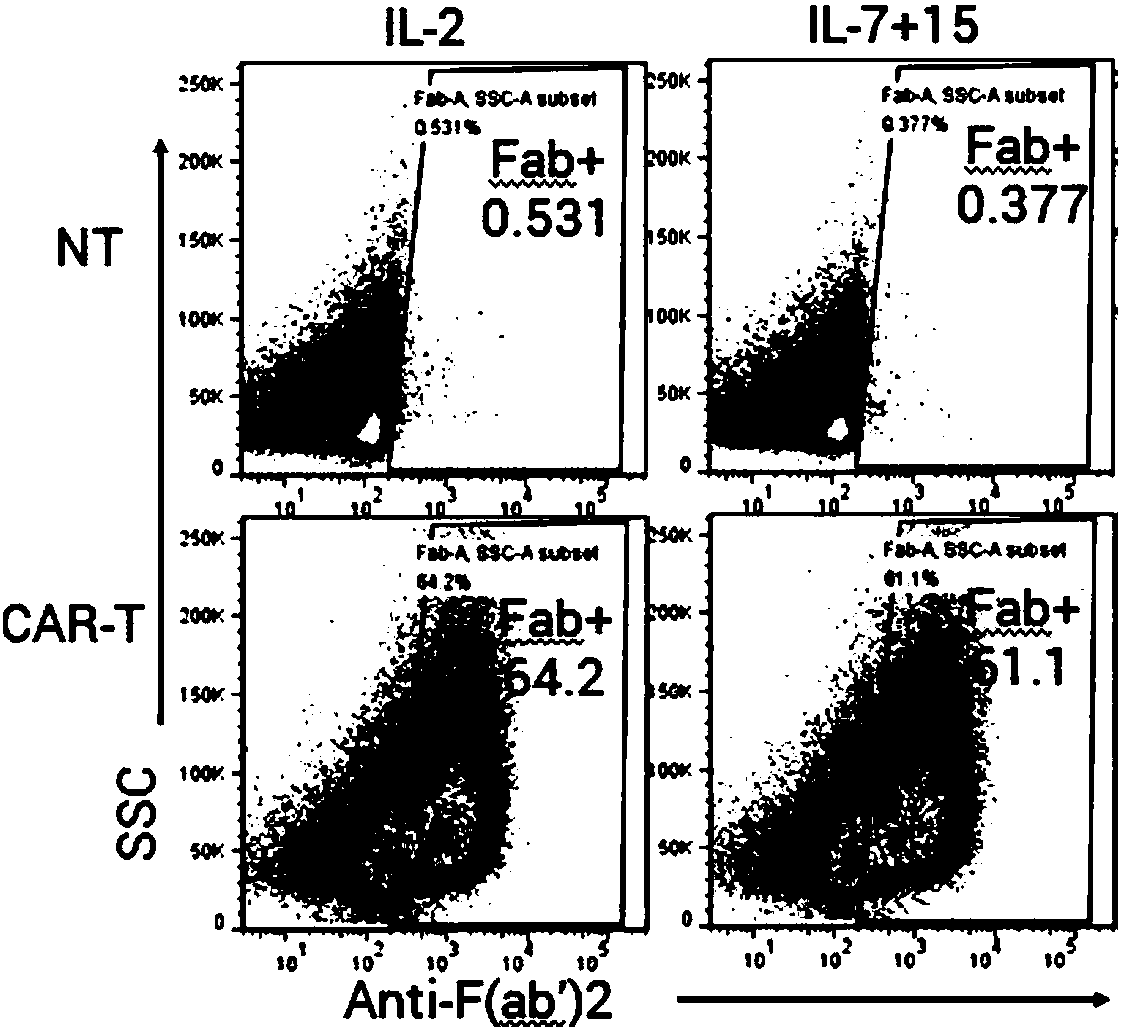Method for cultivating T memory stem cells
A cell, amino acid technology, applied in the field of genetically modified T cells, can solve the problems of lack of antigen persistence and increased activity
- Summary
- Abstract
- Description
- Claims
- Application Information
AI Technical Summary
Problems solved by technology
Method used
Image
Examples
Embodiment 1
[0084] Example 1: Determination of mCD19scFv-CD8α-CD28-CD3ζ gene sequence
[0085] From the NCBI website database, the gene sequence information of human CD28 transmembrane region, human CD28 intracellular region and human CD3ζ intracellular region was searched. The anti-CD19 single-chain antibody clone number is FMC63. These sequences are available on the website http: / / Codon optimization is performed on sg.idtdna.com / site to ensure that it is more suitable for expression in human cells without changing the encoded amino acid sequence.
[0086] Using overlapping PCR, the above sequences were sequentially connected according to anti-CD19 scFv, human CD8α hinge region gene, human CD28 transmembrane region gene, human CD28 intracellular region gene, and human CD3ζ intracellular region gene sequence, and different restriction enzymes were introduced at the junction of each sequence. site to form complete mCD19-CAR gene sequence information.
[0087] The nucleotide sequence of t...
Embodiment 2
[0092] Example 2: Retroviral packaging
[0093] 1. On the first day, the 293T cells should be less than 20 passages and not overgrown. Plate at 0.6*10^6 cells / ml, add 10ml of DMEM medium to a 10cm dish, mix the cells well, and culture overnight at 37 degrees.
[0094] 2. On the second day, the confluence of 293T cells reaches about 90% for transfection (usually about 14-18 hours after plating); prepare plasmid complexes, the amount of various plasmids is 12.5ug for Retro backbone, 10ug for Gag-pol, and 10ug for VSVg 6.25ug, CaCl2 250ul, H2O 1ml, the total volume is 1.25ml; add HBS equal to the volume of the plasmid complex in another tube, and vortex for 20s while adding the plasmid complex. Gently add the mixture to the 293T dish along the side, incubate at 37°C for 4 hours, remove the medium, wash it with PBS, and add pre-warmed fresh medium again.
[0095] 3. Day 4: 48 hours after transfection, collect the supernatant and filter it with a 0.45um filter, store in -80 degre...
Embodiment 3
[0096] Example 3: Retrovirus infection of human T cells
[0097] 1. Use Ficcol separation medium (Tianjin Haoyang) to separate relatively pure CD3+ T cells, and use 5% AB serum (GEMINI) X-VIVO (LONZA) medium to adjust the cell density to 1×106 / mL. Inoculate the cells with 1ml / well into the anti-human 50ng / ml CD3 antibody (Beijing Tongli Haiyuan) and 50ng / ml CD28 antibody (Beijing Tongli Haiyuan), and then add 100IU / ml interleukin 2 (Beijing Tongli Haiyuan) Shuanglu), 10ng / ml interleukin 7 (Peprotech), 5ng / ml interleukin 15 (Peprotech), virus infection after stimulating culture for 48 hours;
[0098] 2. The next day after T cell activation culture, PBS diluted to a final concentration of 15 μg / ml Retronectin (Takara) coated non-ti issue treated culture plate, 250 μl per well of a 24-well plate. Protected from light, overnight at 4°C for later use.
[0099] 3. After T cell activation and culture for two days, two coated 24-well plates were taken out, the coating solution was d...
PUM
 Login to View More
Login to View More Abstract
Description
Claims
Application Information
 Login to View More
Login to View More - R&D
- Intellectual Property
- Life Sciences
- Materials
- Tech Scout
- Unparalleled Data Quality
- Higher Quality Content
- 60% Fewer Hallucinations
Browse by: Latest US Patents, China's latest patents, Technical Efficacy Thesaurus, Application Domain, Technology Topic, Popular Technical Reports.
© 2025 PatSnap. All rights reserved.Legal|Privacy policy|Modern Slavery Act Transparency Statement|Sitemap|About US| Contact US: help@patsnap.com



